Introduction by the National Librarian and Chief Executive
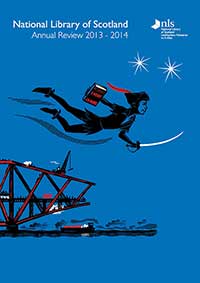
Review.
Cover desgn: Iain McIntosh.
What do a bus shelter on Shetland, the 200 anniversary of the birth of the explorer David Livingstone, the diary written by the commander of the British Army during WW1 and the popular website Wikipedia have in common? The answer is that they all featured in various ways in the work of the National Library of Scotland (NLS) in the past year, illustrating the huge range of activity that goes on every day across the organisation.
The bus shelter on Unst was chosen as one of the Scottish websites that historians of the future may choose to study to discover how we lived in the early years of the 21st century. It has become a tourist attraction due to the power and reach of the internet. This remote location was being celebrated as legal deposit libraries across the UK and Ireland were given the power to start collecting and storing websites in the same way that printed material has been collected for centuries. This landmark development, warmly welcomed by the Library, means the growing proportion of the nation's cultural and intellectual output that appears in digital form can be preserved and saved for future generations.
David Livingstone's travels in Africa were the subject of our main summer exhibition that focussed on the sketches, paintings, photographs and maps he brought back which were the first images people in Victorian Britain ever saw of Africa. The exhibition received many positive comments from visitors and helped to contribute to a pleasing 6% increase in exhibition visitors throughout the year.
One of the treasured items held by the Library is the diary written by Field Marshal Earl Haig in the First World War. Its importance was recognised when it became the latest in a series of items from the Library to be added to the UK Memory of the World Register. This online register promotes the importance of documentary heritage across the UK and the world and is run by the United Nations Educational, Scientific and Cultural Organization (UNESCO).
Widening access to the wealth of material held within our collections is one of our goals. As part of that, we entered into a partnership with online encyclopedia Wikipedia aimed at sharing the richness of the Library's collections with a global audience. A temporary post of Wikimedian-in–residence was created to work with staff and the public to add content to Wikipedia which is the sixth most popular website in the world.
These are just four examples of the many ways in which we are strengthening our collections, helping to interpret and communicate the knowledge held within them, and making them more accessible and available to people across Scotland and the wider world.
Progress continues to be made on developing a new home for the Scottish Screen Archive within the redevelopment of the Kelvin Hall in Glasgow. This will give improved public access to more than 100 years of Scottish history on film and video as well as providing a good base for the Library in the west of Scotland from where people can use our digital collections. Major renovation work started throughout the year on our main building in Edinburgh. The repairs and maintenance are essential to ensure the Library's world class collections are housed in the best conditions possible.
The development of the internet has meant that at no time in our history has it been easier to share the story of Scotland with a global audience. Many more people currently access our collections online than ever come into one of our buildings. That is why the digital strategy that we worked on throughout the year is so important in ensuring that we make the most of the opportunities offered by the information revolution.
We welcomed seven new members to the Library's Board in early 2014 and they will be responsible for guiding the future development of the organisation. They have all achieved prominence in their respective fields and will play a key role in determining the strategies, policies and priorities for the Library in the coming years.
This annual report also marks my last as National Librarian. I joined the Library in 2002 and have been very proud to lead NLS during what has proved to be a period of development and innovation. A key focus has been on widening public access to the collections which led to the opening our popular visitor centre along with the successful programme of events and exhibitions.
The Library plays a crucial role in the life of Scotland through acting as custodian for our written heritage as well as supporting education, research, business and innovation. It has been described by the Culture Secretary Fiona Hyslop as one of Scotland's national treasures. Its strength lies in the richness of the collections and in the skills of its staff who make it such a special place.
It has been a real privilege to have been at the centre of the organisation for over a decade and I look forward to seeing it grow and develop further in the years to come.
Martyn Wade
National Librarian and Chief Executive
Inspiring collections
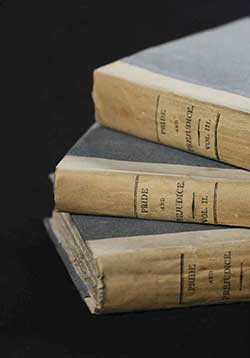
Our collections tell the story of Scotland and contain many unique and globally important items related to important figures including Mary Queen of Scots, Robert Burns, Adam Smith, Walter Scott, David Hume, Lord Byron, Robert Louis Stevenson and many more.
Every week around 5000 new items are added to the collection which has material in more than 490 languages. The importance of collections was again recognised by the United Nations Educational, Scientific and Cultural Organization (UNESCO) this year when the First World War diary written by Field Marshall Earl Haig was added to the UK Memory of the World Register. This is the sixth time that material from the Library's collections has been added to the register which promotes the importance of documentary heritage across the UK and the world.
We are one of six libraries in the UK and Ireland that has the legal right to claim a copy of everything printed in the UK. This is the key to our collecting. From April 2013 this was extended to UK electronic publications and we have begun collecting, preserving and providing access to the increasing proportion of the nation's cultural and intellectual output that appears in digital form — including blogs, e-books and the entire UK web domain. This is an important addition to the collections and will provide vital information to the researchers of the future on life and society in the UK in the 21st century.
Significant additions to our collections throughout the year included:
- Personal and literary papers of the author and Booker Prize winner, James Kelman. This constitutes the only collection of manuscripts and papers of a Booker Prize winner in NLS and covers his literary, political and humanitarian activities
- Further additions to the collections of archives of Scottish writers and cultural figures including Alison Fell, Ian Hamilton Finlay, Alasdair Gray, Alastair Reid and Muriel Spark
- The archive of the Ernest Press, a specialist mountaineering publisher
- A number of printed items relating to the activities of Scots overseas including a very rare Canadian publication from 1791, 'Rules for the regulation of the North-British Society, in Halifax, Nova-Scotia'.
Our free exhibitions, treasures displays and events continue to be popular and provided an opportunity to see and hear about important parts of the collection. The two major exhibitions were 'Picturing Africa' which celebrated the achievements of the Scots explorer David Livingstone and 'Wha's like us?' which presented a selection of Scottish ideas or inventions that have made an impact on the world.
Highlights in our treasures displays included a first edition of Jane Austen's novel 'Pride and Prejudice' and the Glenriddell manuscripts, the single largest collection of Robert Burns's manuscripts in existence. There was also the chance to see some of the more unusual items in the collections including miniature books, some as small as a one penny piece, and the art of pop up books.
Connecting knowledge
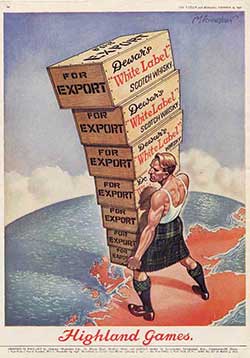
The rapid worldwide distribution of knowledge, information and ideas through the internet is changing the way we all live and the Library is determined to make the most of the opportunities this offers.
Our website already hosts a popular digital gallery which introduces people to many of the riches in the collections. This can be viewed by anyone, anywhere in the world who can connect to the internet. We want to make more of the collection available electronically and have agreed a new contract to digitise more material including Gaelic books, Army lists covering WWI, trade directories, antiquarian Scottish books and printed music collections. This will add a further 1.2 million pages to our existing digitised content. Digitisation delivers greater access. In the last three years we have had one million downloads of the 5,000 books we have digitised from our own collections.
At the same time, we have agreed a new digital content licensing policy, based on the principle of making information openly available where there are no legal, contractual, privacy or related restrictions. This will allow the Library’s digital content, such as our collection of photographs from the First World War, to be shared and used for learning by people across the globe.
Further evidence of our commitment to increasing access to knowledge has come through the appointment of a Wikimedian-in-residence at the Library. This role involves working with NLS staff and the public to add content to the free online encyclopaedia, Wikipedia.
Online maps continue to be popular on our website and several new series were added throughout the year. These included Ordnance Survey maps of all of England and Wales from Victorian times to the 1950s which show how towns and cities have grown and developed.
We continue to support book festivals across Scotland and have an active education and outreach programme which brings the work of the Library to people living in different parts of the country. This encourages people to use the Library’s services, either in person or online.
Marketing activity helps to explain what is on offer and we were delighted to win some major awards for our promotional activities. The Library won the Grand Prix at the 2013 Scottish Creative Awards for the marketing campaign to promote our exhibition on 100 years of Scottish cinema. Our magazine 'Discover NLS' was also named as Customer Magazine of the Year in the 2013 Scottish Magazine Award.
Working in partnership
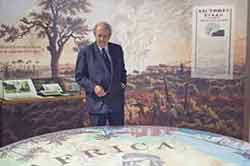
We achieve more by working with in partnership with others. That was ably demonstrated in the close working that has taken place across the UK to set up the systems needed to begin collecting, preserving and making accessible digital information such as e-books and internet content. All legal deposit libraries have joined together to ensure that information that is only available in a digital form can be collected in the same way as printed material.
We are the lead organisation, working with a number of partners, in the development of Sound Scotland, a project to collect sound archive material from across the country and make it widely accessible to the public via an online portal.
Partnership is also at the heart of a new system we are exploring with users of the Library on demand-led acquisition. This ensures that we buy items such as e-books and e-journals where there is known to be a demand for them and, as such, creates a more efficient purchasing model.
Members of Scotland's Gaelic community were involved in a project to allow the Library’s main catalogue to be searched in Gaelic as part of the Library's continuing commitment to promote the use of the language. One spin-off from the project has been the development of a list of Gaelic terms relevant to cataloguing which will be shared with other libraries and organisations. This will assist them in translating their catalogue interface into Gaelic and further encourage the use of the language.
We co-operate with libraries and cultural organisations around the world on shared projects. Highlights this year included a loan of two books originally owned by the first President of the United States, George Washington and bearing his signature. Scotland's First Minister Alex Salmond handed the books over to the Fred W Smith National Library for the Study of George Washington at a ceremony at the President's former home at Mount Vernon, outside Washington. A joint exhibition was also held in London, organised by the Library and King's College, London, entitled 'Byron and Politics'.
A display of five intricate paper sculptures that appeared mysteriously across Scotland proved to be highly popular. They were created by an anonymous artist and left in various locations in celebration of Book Week Scotland. The Scottish Book Trust, which organises Book Week Scotland, loaned the sculptures to the Library and they were able to be seen together for the first time. Harry Potter fans were also given a special treat when a rare first edition, filled with personal notes and drawings by the author J K Rowling, went on display for a week. It was loaned to the Library by its anonymous new owner, who had bought it at auction.
We continue to receive generous support from a variety of organisations and individuals who help to fund our work. A special celebration was held to thank them for their support and various events were organised throughout the year for the Library’s patrons and benefactors.
Moving forward
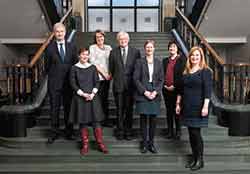
Significant change took place across the organisation in the year under review. Martyn Wade, who has been National Librarian and Chief Executive since 2002, announced that he was to retire at the end of March. Mr Wade led a significant period of innovation at the Library which has widened public access to its collections. He also presided over the acquisition of the world renowned John Murray Archive, led the merger of the Scottish Screen Archive with NLS and expanded online access. He is to be succeeded by Dr John Scally who moves from Edinburgh University where he has been Director of University Collections.
Seven new members joined the Library's Board in February, as part of a process which will see the entire board membership refreshed by 2015. Board members are responsible for determining the strategies, policies and priorities for the Library as it seeks to make the knowledge and information held within its world-class collections as widely available as possible.
The NLS Foundation, which was set up as a charitable body in 2012 to provide financial support for special projects at the Library, continued to map out its role and develop positive working relationships.
The Heritage Lottery Fund awarded a grant of £4.57 million towards the redevelopment of Glasgow's Kelvin Hall which will include a new home for the Scottish Screen Archive and expanded facilities for the Library in Scotland’s biggest city. The redevelopment is a joint project between between Glasgow City Council, Glasgow Life, the University of Glasgow and the Library and will transform the historic building into an exciting new centre of cultural and sporting excellence.
Scaffolding was erected around our main building in Edinburgh for a period of several months to allow essential maintenance work to take place. This provided an opportunity to drape the scaffolding with eye catching hoardings featuring drawings of famous characters ranging from Long John Silver to James Bond and Mary Queen of Scots. The artwork showed the characters 'walking' into the building where they live as part of our collection. The aim was to draw attention to the Library being open for business as well as highlighting the rich and diverse collections we hold by inviting people to 'discover the world in one place.'
Another innovation was the appointment of a Reader-in-residence responsible for introducing the general collections to a range of new audiences. This was done by hosting a series of weekend events at the library targeted at families, young people and creative individuals, among others.
The National Library of Scotland would like to thank the following donors for their generous support:
Mr and Mrs John N Allan
Professor Michael Anderson and Elspeth MacArthur
Diana Balfour
Mary Baxter
Sir Peter Burt and Lady Burt
Peter and Diane Cabrelli
Professor Graham D Caie
Professor Sir Kenneth and Lady Calman
The Rt Hon The Lord and Lady Cameron of Lochbroom
Kenneth Campbell
Pauline Clarke and Patricia Clarke
Alan Clements
Mr and Mrs Jonathan Cobb
Dr Roger Collins and Dr Judith McClure
Sir Sandy and Lady Crombie
Dr John Cruikshank and Dr Susan Shatto
Professor Sir David and Lady Edward
Sir Gerald and Lady Elliot
Mr Christopher Wilkins and Margaret Elliot
Drs Robert and Sheila Gould
Dr and Mrs Michael Gray
Robert Gregor
Donald Hardie
Edward H Hocknell
Mr and Mrs Dermot J Jenkinson
James and Caroline Knox
Roy Leckie
Charles Lovatt
Dr John MacAskill
Lady Lucinda Mackay
Professor Alexander McCall Smith and Dr Elizabeth McCall Smith
Dr Warren McDougall
Dr Karina McIntosh
Jim Mellon
Moira Methven
Mr and Mrs James Miller
Ian W Moffett
Mr and Mrs H J Morgan
Dr Henry Noltie
Robert J O'Riordan
Dr Richard Parsons
Charles and Ruth Plowden
Jenny Purcell
Professor David Purdie
Patrick H Reeve
David Rumsey
Sir Muir and Lady Russell
Norman Springford
The Rt Hon The Lord David Steel of Aikwood and Lady Steel
The Rt Hon The Lord and Lady Sutherland of Houndwood
Graham Thorpe
Mr Tom Walker and Dr Walker
Mr Max Ward and Lady Sarah Ward
Sarah J M Whitley and Graham Whyte
Mr W James Wolffe and Lady Wolffe
Dr William Zachs and Mr Martin Adam
American Patrons of the National Library and Galleries of Scotland
Australians Studying Abroad
Binks Trust
David Livingstone 200 Project
J & R Freedman Charitable Trust
Samuel H Kress Foundation
Stichting Teuntje Anna (TA Fund)
The Alma & Leslie Wolfson Charitable Trust
The Michael Marks Charitable Trust
The Mickel Fund
The Trusthouse Charitable Foundation
The W S Wilson Charitable Trust
University of the Third Age
Legacies:
Miss Mary E Mackenzie
George McElroy
What people say
Kirsty Regan @KirstyRegan
Just back from an excellent (free) workshop at @natlibscot on accessing the digital newspaper archive. A girl could get lost in there!
Margaret Fox@mf6060
There's always exciting things going on @natlibscot What a great online #maps resource: http://bit.ly/1l0C1Oo
Kylie Mirmohamadi@vic_reader
@MsFloraPoste Oh the folk at @natlibscot — just so unbelievably nice. A truly warm & supportive research environment.
Jo Hawkins@history_punk
What a truly extraordinary place the @natlibscot is. I have been able to access nearly every Australian #WW1 book I need. Even from 1930s!
Catriona Chapman@CatrionaChapman
About to spend a morning in @natlibscot doing some research! One of my favourite places in Ed!
Tripadvisor
Janice W: 'I made the trip to Edinburgh especially to view a collection in the NLS. The staff were very helpful and I was able to find everything I had hoped for. Further really useful information to add to my family tree.'
Simon Macintyre: 'Went to the National Library of Scotland yesterday for St Andrews Day celebrations and thought I should tell everybody. This place is amazing. It was a kind of open day and they have there librarians siting at desks with some of the stuff they had pulled form their massive depository of books.'
Birjins: 'The current exhibition is about Dr David Livingstone and his African expedition, and the whole exhibit was superb in its presentation, lively colourful, interactive. Best part … free! Highly recommended.'
Biggercam: 'If you need to consult any British publication of the last hundred years or so, it will definitely be here. The staff are wonderfully helpful, but be aware that this is a reference facility only – you can't take documents away with you.'
Other comments
Sam C, Manchester, on yelp.co.uk: 'Free papers, great coffee, numerous BBC news viewing screens, and all encased within opulent surroundings. Plenty of space and the most comprehensive book selection you'll get in Scotland equate to a high ranking library.'
Euan's Guide website which rates venues on access for people with disabilities: 'One of Edinburgh's hidden gems.'
